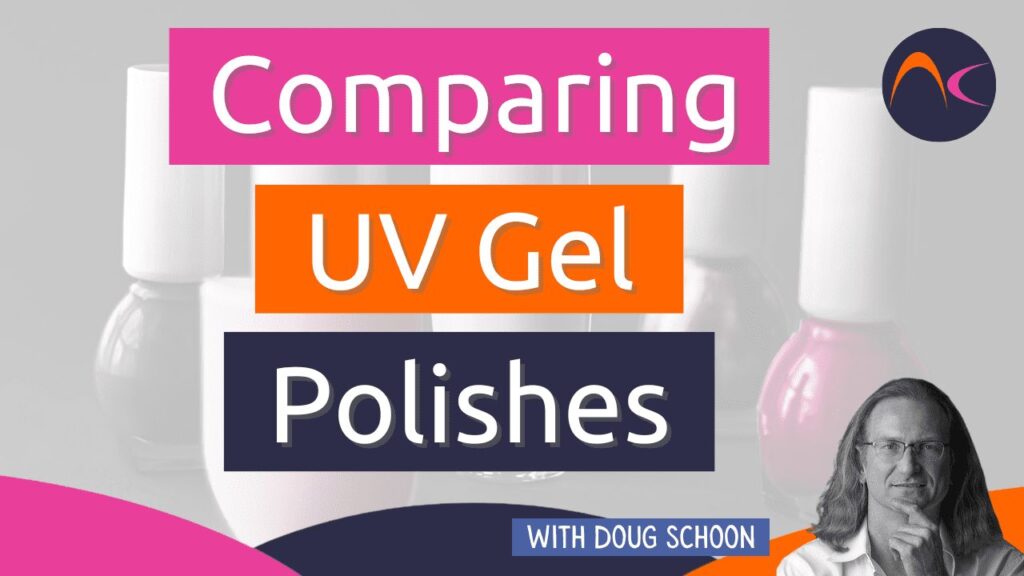Many nail pros right now are comparing UV gel polishes. But how can you tell if it’s a good one or not? What should you look out for exactly? And… what should you steer clear of? What would be the UV gel polish with the best-case scenario ingredients?
I am glad to see that many are looking at the SDS of each brand. Every salon should have these for every product they use in the salon. For those that don’t know, SDS stands for Safety Data Sheet (aka MSDS). These information sheets are used around the world by many different types of professionals, including firefighters, truckers, shippers, packagers, etc. The SDS teaches important information about safe use.
For instance, they provide emergency contact phone numbers, first aid information, proper storage, flammability warnings, safety precautions, and proper disposal information. They even provide signs to watch out for, which may indicate the products are being improperly used. They also provide signs and symptoms, if any, for both short-term and long-term overexposure. You won’t be able to tell a good UV gel from a poor one by reading these safety data sheets. Why? That’s not what these data sheets are designed to do. The SDS tells you what you need to know to work safely with the product and doesn’t consider product quality or performance. All brand-name nail products can be used safely when they are used correctly. By correctly, I mean that all manufacturers’ directions are followed and all warnings or precautions are heeded, including those listed on the safety data sheet.
To answer the rest of the questions, I don’t think there is such a thing as “best scenario ingredients”. It’s not that simple to tell how well a UV gel will work, especially given that if a nail professional misuses the very best UV gel in the world, it won’t work very well. Many will blame the product, when in fact they used the product incorrectly.
That’s one of the biggest challenges facing the nail industry. Too many nail technicians don’t read or follow directions and they mix together things that should not; many technicians incorrectly cure nail coatings. Of course, the reverse is true; a great nail tech can make even a poor-quality UV gel work pretty well. These safety data sheets and the ingredient listing can warn you about ingredients that you may be allergic to so you can avoid exposure, so that’s another way they are useful.
I did want to add something else. It used to be that we read the labels to find out what’s in the products. Many people read the labels to find out what’s NOT in the product. That doesn’t make a lot of sense. Unless you are allergic, what does it matter what isn’t in the products? Labels often contain cleverly spun marketing messages. For instance, “this product is XYZ-free!”. This claim is very often a tool to fool people. A good example is acetone-free. So what if the product is acetone-free? Acetone doesn’t cause allergic reactions and salons can use it safely. Acetone-free doesn’t tell you what’s in the products. Maybe the solvent used to replace acetone isn’t as safe as acetone.
When people see the XYZ-Free claim, they automatically assume that XYZ must be dangerous. That’s a clever ploy that many fear-based marketers use to fool people into thinking their products are safer, when in fact they may be no safer… and may even be less safe.
“Three-free” is another example and now some are claiming to have “ten-free” nail polishes. They often don’t even bother mentioning what they are supposedly free from and they don’t need to bother. They know this claim will frighten many into buying their products, regardless of what they don’t contain. My advice is this, don’t buy a product based on what it doesn’t contain. Don’t let fear drive your buying decisions and be very wary of marketers that use fear to sell their products. Buy from companies that provide fact-based information, not fear. Good nail products don’t need to be marketed with fear. Good marketers don’t need to stoop to these types of deceptive practices. Be informed and make informed purchases when comparing UV gel polishes. Read the safety data sheets and use the products properly. That’s the best way to ensure you are working safely.


